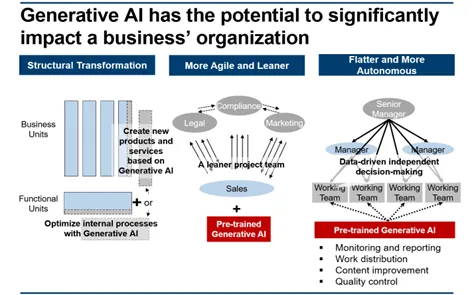With rapid technological advancements, AIGC has become a vital domain, utilizing advanced algorithms to automatically create content such as text, images, audio, and video. Particularly in China, this technology has been widely applied across various business sectors, including retail, manufacturing, new energy vehicles (NEVs), healthcare, education, and tourism. Looking ahead, the application prospects for AIGC will be even broader, potentially covering more intelligent robotic assistants and providing more personalized user experiences.
Entering the Era of Generative AI
We are entering a new era of AIGC, where this technology is becoming a key force driving enterprise transformation and upgrading. With continuous AI advancements and enhanced data processing capabilities, businesses can utilize these tools to optimize decision-making processes, improve operational efficiency, and innovate products and services. As competition in the AI industry intensifies between China and the US, numerous innovative companies such as OpenAI, Alibaba, Baidu, and SenseTime continually push the boundaries of AI technology. These companies, through relentless technological innovation, have evolved from machine learning (narrow AI) to machine perception (general AI) and are gradually advancing towards machine cognition (super AI). It is anticipated that in this stage, AI will be capable of advanced cognitive learning, surpassing human abilities and providing more efficient problem-solving and decision-making capabilities. Although we have yet to enter the third stage fully, the rapid development of AIGC shows great potential for reaching higher levels of intelligence.
AIGC offers unique benefits to various industries by significantly enhancing customer experience and engagement through automated content creation. It also enables real-time analysis of large datasets, quickly identifying market dynamics and consumer behavior changes, helping businesses swiftly adjust strategies to stay competitive. This data-driven decision-making process significantly reduces decision costs, enhancing a company’s competitiveness and market responsiveness. Additionally, the application of AIGC promotes continuous improvement and iterative innovation. Businesses can learn from user feedback and behavior data, continuously optimizing products and services, thereby maintaining a leading position in a constantly changing market environment.
With rapid technological advancements, AIGC has become a vital domain, utilizing advanced algorithms to automatically create content such as text, images, audio, and video. Particularly in China, this technology has been widely applied across various business sectors, including retail, manufacturing, new energy vehicles (NEVs), healthcare, education, and tourism. Looking ahead, the application prospects for AIGC will be even broader, potentially covering more intelligent robotic assistants and providing more personalized user experiences.
Entering the Era of Generative AI
We are entering a new era of AIGC, where this technology is becoming a key force driving enterprise transformation and upgrading. With continuous AI advancements and enhanced data processing capabilities, businesses can utilize these tools to optimize decision-making processes, improve operational efficiency, and innovate products and services. As competition in the AI industry intensifies between China and the US, numerous innovative companies such as OpenAI, Alibaba, Baidu, and SenseTime continually push the boundaries of AI technology. These companies, through relentless technological innovation, have evolved from machine learning (narrow AI) to machine perception (general AI) and are gradually advancing towards machine cognition (super AI). It is anticipated that in this stage, AI will be capable of advanced cognitive learning, surpassing human abilities and providing more efficient problem-solving and decision-making capabilities. Although we have yet to enter the third stage fully, the rapid development of AIGC shows great potential for reaching higher levels of intelligence.
AIGC offers unique benefits to various industries by significantly enhancing customer experience and engagement through automated content creation. It also enables real-time analysis of large datasets, quickly identifying market dynamics and consumer behavior changes, helping businesses swiftly adjust strategies to stay competitive. This data-driven decision-making process significantly reduces decision costs, enhancing a company’s competitiveness and market responsiveness. Additionally, the application of AIGC promotes continuous improvement and iterative innovation. Businesses can learn from user feedback and behavior data, continuously optimizing products and services, thereby maintaining a leading position in a constantly changing market environment.
In supply chain management, the application of AI makes the entire chain more transparent and efficient. Through real-time data analysis, companies can quickly respond to market changes, optimize inventory and logistics decisions, and reduce operational costs. Moreover, AI technology helps businesses mitigate supply chain risks by using predictive analytics to proactively address potential disruptions, ensuring the stability and sustainability of the supply chain.
AI technology is revolutionizing the agricultural cycle, from pre-production research and supply to post-production quality control and traceability. It utilizes image recognition and remote sensing for land and crop analysis, precision planting, and intelligent pest and disease monitoring. These advancements enhance the efficiency and reliability of the agricultural production chain, boosting productivity and reducing costs for sustainable development.
For instance, the Chinese Academy of Agricultural Sciences has made significant strides in rice breeding by combining gene editing with AI analysis to enhance crop yield and adaptability. On the sales and supply chain side, AI enables more accurate market targeting and personalized marketing, improving transaction efficiency and customer satisfaction. Tech giants like JD.com, Baidu, and Alibaba use their cloud computing and AI platforms not just for precise marketing of agricultural products but also to make supply chains more transparent and flexible, significantly cutting operational costs and time. This shift is driving the transformation from traditional to smart agriculture.
Additionally, generative AI is also changing the automotive industry. In the development and manufacturing sector, Mercedes-Benz is pioneering autonomous driving tests using AI, enhancing the technology’s cutting-edge status and safety. Companies like Toyota, BYD, and Li Auto use AIGC to profile customers and create marketing content, offering a more immersive and personalized purchase experience in the sales process. During the vehicle usage phase, OEMs and Tier 1 suppliers such as Tesla, Xpeng, NIO, Bosch, Huawei, and Xiaomi are working together to significantly improve the driving experience through connected car technologies, assisted driving, autonomous driving, and in-vehicle AI chips in smart cockpits.
These technologies not only improve the driving experience but also change the way people travel. For OEMs, using AI helps track market trends more accurately, cuts costs, and boosts both production efficiency and product quality, leading to significant commercial gains. As technology advances, features like autonomous driving keep improving, making vehicles more competitive. In supply chain management, AI’s reliance on software and IT boosts efficiency and causes significant changes in the automotive industry. With the growth of shared mobility services, the traditional car ownership model is also evolving, suggesting that future supply chains will be more adaptable and able to offer more efficient mobility services.

AIGC is driving major changes in traditional industries, leading to shifts in corporate structures that make businesses more agile, flexible, and autonomous. This evolution not only speeds up operations and fosters innovation but also makes decision-making faster. However, the broad adoption of AIGC comes with its share of risks and ethical challenges, like data privacy issues, copyright problems, recognition biases, and the impact on employment. These concerns require thorough discussions and effective regulation by businesses, policymakers, and the wider community to ensure that tech advancements align with social ethics and legal norms.
In this regard, China’s “Interim Measures for the Management of Generative Artificial Intelligence Services,” introduced in July 2023, marks the world’s first detailed national regulation on AI. This move puts China at the forefront of global AI governance and offers valuable insights for other nations crafting similar regulations. These guidelines help ensure that businesses and developers use AIGC technology safely and ethically, aligning tech development with legal standards and advancing AI technology towards a better future.
This article was originally published by Gao Feng Advisory Company Ltd.





















